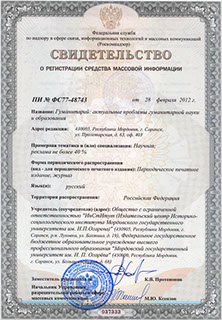ГуманитариЙ актуальные проблемы гуманитарной науки и образования
Russian Journal of the Humanities
ISSN 2078-9823 (Print)
ISSN 2587-7879 (Online)
Navigation
ISSN 2078-9823 (Print), ISSN 2587-7879 (Online)
DOI: 10.15507/2078-9823.062.023.202302.233-246
Pavel D. Minichkin
Children’s Art School No. 8 (Saransk, Russia), e-mail: mini4ckin.paw@yandex.ru
Features of the Partipation of a Russian Fairy Tale in the Model
of the Female Self
Abstract
Introduction. The study of a fairy tale leads to an understanding of the deep processes of the global world, the desire for localization, glocalization. The Russian fairy tale in the model of the female “I” is the postulate of a modern reading and the search for one’s place in the world, since the inability to adequately read life, real and fabulous ideological, leads to a detached state of personality, the muscularity of character and external features is the need for counteraction and integration into the call-response system time.
Materials and Methods. The article is written taking into account the systematic and interdisciplinary approaches. For the study were used Russian folk tales as presented by:
P. P. Ershov “The Humpbacked Horse”, A. N. Afanasiev: “The Firebird and Vasilisa-Tsarevna”, “Koschey the Immortal”, “Sivka-Burka”, A. S. Pushkin: “The Tale of Tsar Saltan”, “The Tale of the Fisherman and the Fish”. Also, tales without authorship: “The Queen and His Uncle”, “Sorcerer’s water”, “Elena the Wise”, “Ivan Bykovich”, “Robbers”, “True and False”, “The Three Kingdoms of Copper, Silver and Gold”, “The Feather of Finist the Clear Falcon”, “The Witch and the Sun Sister”.
Research Results. Russian fairy tales as models of women’s self-perception were studied. The values of the people as a cultural historical and current society were evaluated in the categories, the centers of which served at different times as a social change, the dialogue of cultures, which became a unifying and constitutive vector of development of the idea of women’s share. Elements of belonging and alienation are the result of interpenetration of traditions of all peoples of the Russian state, which is why the identification and subsequent comprehension of “folk traits” is relevant, since the elements of hostility as well as friendly reconciliation are mutually excluded, which leads to many pathologies of the social organism, the individual.
Discussion and Conclusion. Identification of the female category of attitude to the world in the “good/evil” system in an interdisciplinary approach is possible in such structures as aesthetic, philosophical, semiotic figurative representation. The content of the artistic content should be scientifically comprehended and adapted at the present time as a guarantee of the semantic characteristics of a successful assessment of the system of knowledge about society, the role of women in society, in a number of issues about the feminization of key issues in life aspects: education, culture, legal culture.
Keywords: fairy tale, plot, woman, image, people, society.
For citation: Minichkin P. D. Features of the Partipation of a Russian Fairy Tale in the Model of the Female Self. Gumanitarian: aktual’nye problemy gumanitarnoi nauki i obrazovaniia = Russian Journal of the Humanities. 2023; 23(2): 233–246. (In Russ.). DOI: 10.15507/2078-9823.062.023.202302.233-246.

© Ogarev Mordovia State University. History and Sociology Institute, 2017
68, Of. 411, Bolshevistskaya St., 430005, The editorial office of the scholarly journal «Russian Journal of the Humanities»
Tel.: (8342) 24-25-90; 27-07-11, Fax: (8342) 24-25-90, E-mail: jurnal-econom-hist@isi.mrsu.ru
Designed by A. Napalkov, Email: napalkov@isi.mrsu.ru

